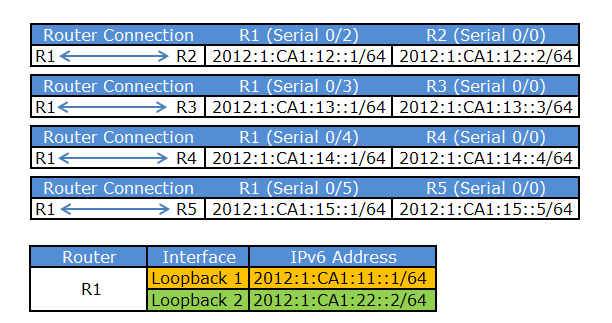- Cisco Community
- Technology and Support
- Networking
- Networking Knowledge Base
- Configuring IPv6 BGP Peering with Peer-Group Command
- Subscribe to RSS Feed
- Mark as New
- Mark as Read
- Bookmark
- Subscribe
- Printer Friendly Page
- Report Inappropriate Content
- Subscribe to RSS Feed
- Mark as New
- Mark as Read
- Bookmark
- Subscribe
- Printer Friendly Page
- Report Inappropriate Content
01-17-2012 07:45 AM - edited 03-01-2019 04:46 PM
Introduction
BGP Neighbors associated in a Peer-Group share similar routing policies. Update policies are usually set by route maps, distribute-lists and filter-lists, etc. Instead of defining the same policies for each separate neighbor, we define a peer group name and assign these policies to the peer group.
Members of the peer group inherit all of the configuration options of the peer group. Members can also be configured to override these options if these options do not affect outbound updates; you can only override options set on the inbound.
The command to configure peer group is neighbor peer-group-name peer-group and to associate a member to a group is neighbor {ipv4/ipv6 address} peer-group peer-group-name .
NOTE: The members of a peer group may not necessarily be in a same autonomous system.
Background
In this documentation, we are configuring IPv6 EBGP relationship by creating two peer groups on Router R1, named BOISE and MONTANA. Neighbors associated in group BOISE are R2 & R3 whereas R4 & R5 are associated with group MONTANA. For demonstration, we have configured two route-maps for each peer-group.
The command to attache peer-group with the route-map is neighbor peer-group-name route-map route-map-name out/in, the command is configured under the address-family mode.
All configurations are carried in Lab environment on Cisco 3745 Router operating on Cisco IOS 12.4 version.
Topology Summarization

Topology Diagram

Configuration
Summary Steps
- enable
- configure terminal
- router bgp as-number
- neighbor peer-group-name peer-group
- neighbor {ip-address | ipv6-address[%] | peer-group-name} remote-as autonomous-system-number [alternate-as autonomous-system-number ...]
- address-family ipv6 [vrf vrf-name] [unicast | multicast | vpnv6
- neighbor {ip-address | peer-group-name | ipv6-address %} activate
- neighbor ip-address | ipv6-address} send-label
- neighbor {ip-address | ipv6-address} peer-group peer-group-name
- exit
Router R1
R1
hostname R1 ip cef no ip domain lookup ipv6 unicast-routing
interface Serial0/2 no ip address ipv6 address 2012:1:CA1:12::1/64 ipv6 enable clock rate 72000 ! interface Serial0/3 no ip address ipv6 address 2012:1:CA1:13::1/64 ipv6 enable clock rate 72000 ! interface Serial0/4 no ip address ipv6 address 2012:1:CA1:14::1/64 ipv6 enable clock rate 72000 ! interface Serial0/5 no ip address ipv6 address 2012:1:CA1:15::1/64 ipv6 enable clock rate 72000 ! router bgp 100 bgp router-id 1.1.1.1 no bgp default ipv4-unicast bgp log-neighbor-changes neighbor BOISE peer-group neighbor MONTANA peer-group neighbor 2012:1:CA1:12::2 remote-as 22 neighbor 2012:1:CA1:12::2 peer-group BOISE neighbor 2012:1:CA1:13::3 remote-as 33 neighbor 2012:1:CA1:13::3 peer-group BOISE neighbor 2012:1:CA1:14::4 remote-as 44 neighbor 2012:1:CA1:14::4 peer-group MONTANA neighbor 2012:1:CA1:15::5 remote-as 55 neighbor 2012:1:CA1:15::5 peer-group MONTANA ! address-family ipv6 neighbor BOISE route-map LIST1 out neighbor MONTANA route-map LIST2 out neighbor 2012:1:CA1:12::2 activate neighbor 2012:1:CA1:13::3 activate neighbor 2012:1:CA1:14::4 activate neighbor 2012:1:CA1:15::5 activate network 2012:1:CA1:11::1/64 network 2012:1:CA1:22::2/64 exit-address-family ! route-map LIST2 permit 10 match ipv6 address LIST_2 ! route-map LIST1 permit 10 match ipv6 address LIST_1 ! ipv6 access-list LIST_1 permit ipv6 host 2012:1:CA1:11::1 any ! ipv6 access-list LIST_2 permit ipv6 host 2012:1:CA1:22::2 any ! end |
Router R2, R3, R4 & R5
R2R3R4R5
hostname R2 ip cef no ip domain lookup ipv6 unicast-routing ! interface Serial0/0 no ip address ipv6 address 2012:1:CA1:12::2/64 ipv6 enable clock rate 2000000 ! router bgp 22 bgp router-id 2.2.2.2 no bgp default ipv4-unicast bgp log-neighbor-changes neighbor 2012:1:CA1:12::1 remote-as 100 neighbor 2012:1:CA1:12::1 ebgp-multihop 2 ! address-family ipv6 neighbor 2012:1:CA1:12::1 activate exit-address-family ! end | hostname R3 ip cef no ip domain lookup ipv6 unicast-routing ! interface Serial0/0 no ip address ipv6 address 2012:1:CA1:13::3/64 ipv6 enable clock rate 2000000 ! router bgp 33 bgp router-id 3.3.3.3 no bgp default ipv4-unicast bgp log-neighbor-changes neighbor 2012:1:CA1:13::1 remote-as 100 neighbor 2012:1:CA1:13::1 ebgp-multihop 2 ! address-family ipv6 neighbor 2012:1:CA1:13::1 activate exit-address-family ! end | hostname R4 ip cef no ip domain lookup ipv6 unicast-routing ! interface Serial0/0 no ip address ipv6 address 2012:1:CA1:14::4/64 ipv6 enable clock rate 2000000 ! router bgp 44 bgp router-id 4.4.4.4 no bgp default ipv4-unicast bgp log-neighbor-changes neighbor 2012:1:CA1:14::1 remote-as 100 neighbor 2012:1:CA1:14::1 ebgp-multihop 2 ! address-family ipv6 neighbor 2012:1:CA1:14::1 activate exit-address-family ! end | hostname R5 ip cef no ip domain lookup ipv6 unicast-routing ! interface Serial0/0 no ip address ipv6 address 2012:1:CA1:15::5/64 ipv6 enable clock rate 2000000 ! router bgp 55 bgp router-id 5.5.5.5 no bgp default ipv4-unicast bgp log-neighbor-changes neighbor 2012:1:CA1:15::1 remote-as 100 neighbor 2012:1:CA1:15::1 ebgp-multihop 2 ! address-family ipv6 neighbor 2012:1:CA1:15::1 activate exit-address-family ! end |
Verification
show bgp ipv6 unicast summary

show bgp ipv6 unicast peer-group

show ipv6 route bgp

References
Find answers to your questions by entering keywords or phrases in the Search bar above. New here? Use these resources to familiarize yourself with the community: